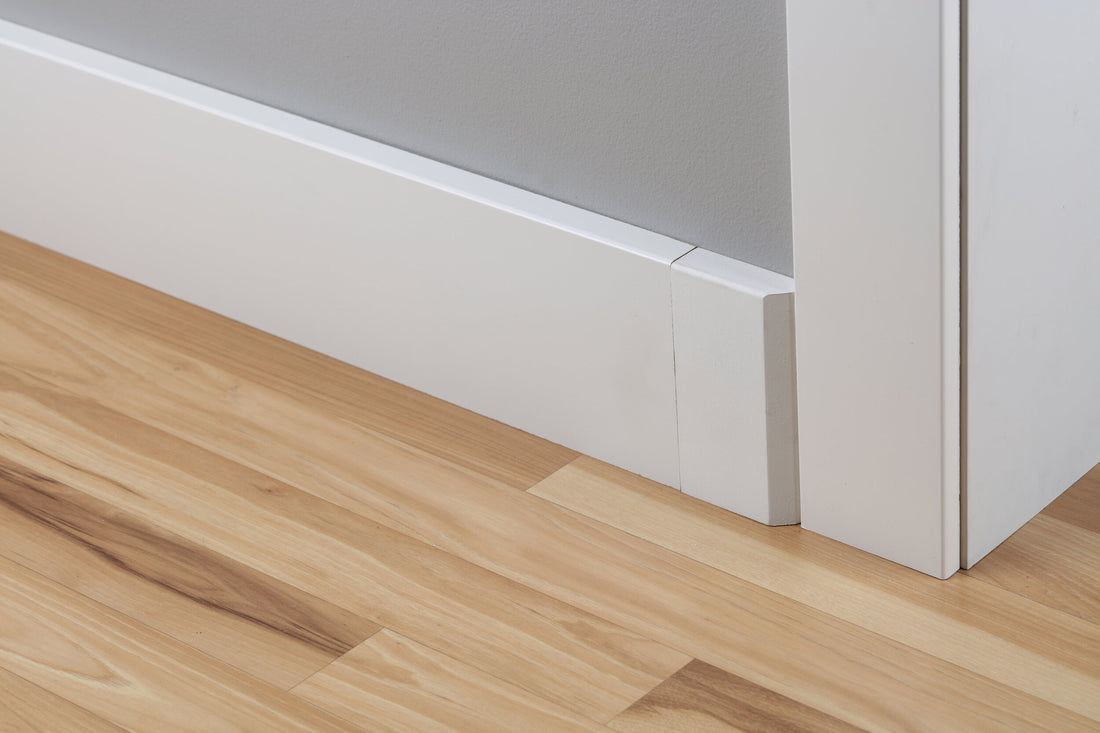A flooring renovation project would not be complete without trim and moulding. Why is that? As you prepare to install your beautiful new floors, it is important to understand what floor trim and moulding are, and why they are so vital.
You can choose from a wide variety of trims, including transitions between floors and baseboards. This guide will help you narrow down your options by explaining why we use floor trim and what types of floor trim are available.
What Are Floor Trims And Mouldings?

Mouldings and trims are flooring edge pieces used to transition your floor from one level to another, along stairs, and along walls. They complete the picture-perfect look of your floor.
Transition pieces are available in a variety of shapes and materials, including rubber, vinyl, medium-density fiberboard (MDF), and more. With these trims, you can easily install them wherever you need them.
What Are The Differences Between Floor Trim and Moulding?
Floor Moulding and trim are very similar, but not the same. The term trim describes the edge material around doors, windows, between floors, on walls, or on ceilings.
Floor Moulding is a type of trim, but it is a more grand, decorative type. The baseboard moulding, for example, creates a custom look in the home by transitioning the floors to the walls.
How to Choose Floor Transitions and Baseboards

It is important to consider a few key factors when selecting a finishing touch for your floors and walls.
1. Location
There are some trims and mouldings that can be used in several different locations, but there are others that are more suitable for specific locations. Firstly, you should determine the location in order to eliminate inappropriate options. After that, you can move on to a more detailed decision-making process.
2. Floor-type
Generally, you want your trim/moulding to match your floor. Fortunately, most types of flooring can be complemented with trims made from rubber, vinyl, or MDF.
3. Size
It is important to consider the size of the transition pieces. Your walls and floors should be lined with baseboards, casings, and other trims that fit and look good.
4. Style
This is where you can choose what appeals to you and what will fit the space that you have. Make sure you take home some samples first to get a sense of how it all looks in person.
What Are The Types of Trim and Moulding
Now that you know what to look for, let us discuss the various trim and moulding.
1. Floor Quarter Round Trim
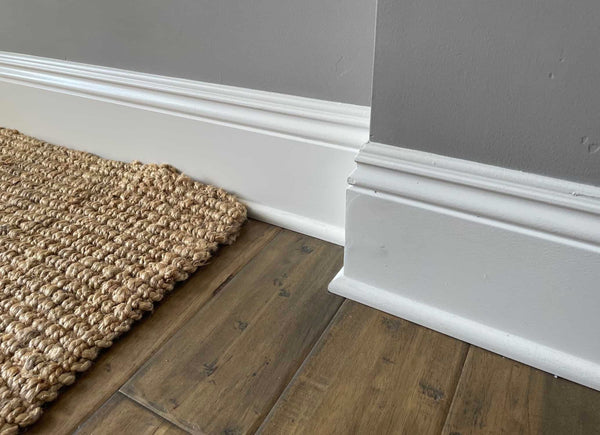
A quarter round is a short baseboard constructed from a quarter of a circle round. It is a simple type of trim and is frequently used as wall trim or in conjunction with a taller baseboard to establish a custom appearance.
Quarter-round trim is particularly useful when there is a gap between the floor and the wall due to expansion. Floors expand and contract in response to changing temperatures, so having a trim to cover the gap will help your floors remain in excellent condition all year long.
- Where To Use It: Transition spaces between floors and walls. The product can also be used against baseboards.
- Compatible Flooring: vinyl, carpet, wood, laminate
2. Floor T-Moulding
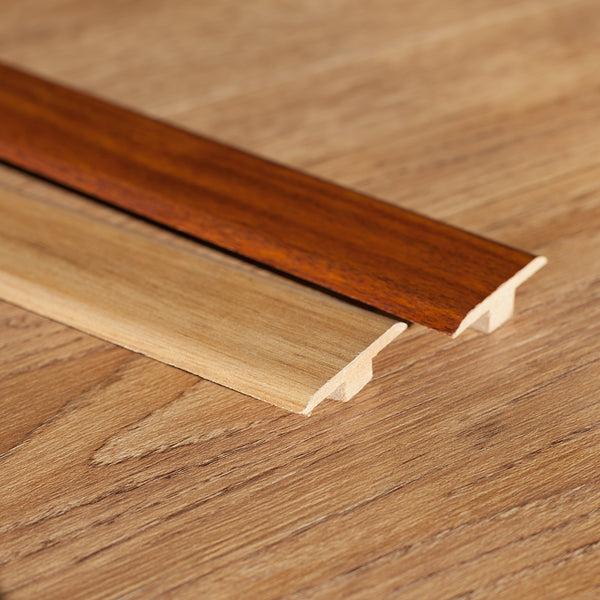
Use a T-mould if you’re transitioning between two floors that are level with each other.
Floor t-moulding is also used to join together two hard surfaces like tile and wood, or even two different tiles or wood planks. The t-moulding gives you a nice transition that is easy on the eyes and keeps things looking sharp and connected.
- Where To Use It: Between two hard surface floors to transition from one floor to the next.
- Compatible Flooring: vinyl, wood, laminate
3. Floor Reducer Trim and Moulding
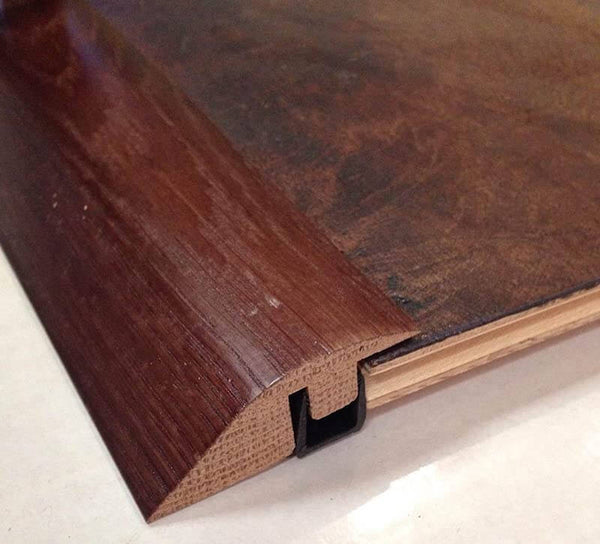
Reducer pieces work with transitions where one floor is higher than the other. For instance, if your living room has hardwood and your kitchen has tile, reducers help compensate for the height difference of each floor so you don’t trip when moving from room to room.
- Where To Use It: For floor-to-floor transitions in which one floor is taller than the other.
- Compatible Flooring: vinyl, carpet, wood, laminate, rubber
4. Floor Thresholds and End Caps
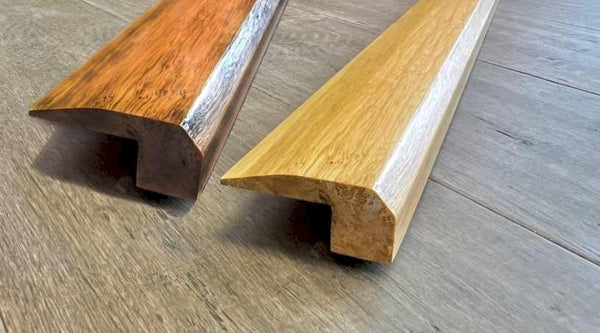
The function of thresholds and end caps is similar to that of reducers. They facilitate the transition between different floors. However, instead of a gradual slope, as is the case with a reducer, these pieces appear as stair steps from one-floor height to the next. Additionally, they work with different textures of floors such as carpet and hard surface floors to help create a more natural-looking transition.
Due to the similarity of these types of trims, an end cap can be used anywhere that a threshold would be used. There is primarily a difference between the two in that threshold pieces sometimes have rounded square edges, whereas end caps tend to have square edges.
- Where To Use It: Between two floors of any kind that are different heights.
- Compatible Flooring: vinyl, carpet, wood, laminate
5. Floor Stair Nose Trim
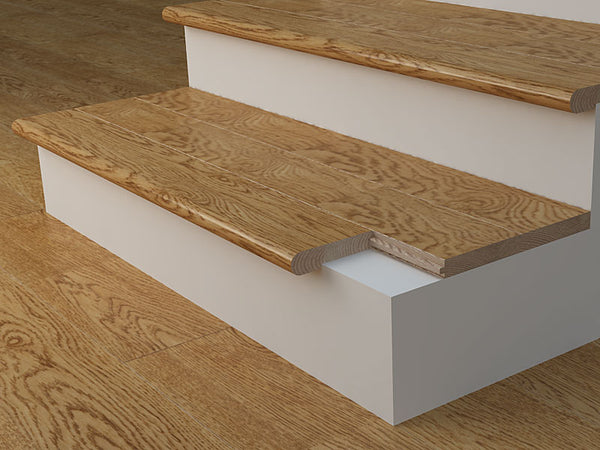
Essentially, this trim is used to finish off the edges of stair steps. The stair nose protects your stairs from wear and tear, softens hard corners, and increases safety.
Furthermore, the stair nose adds a stylish finish to your staircase as well as keeping your floor safe and secure. A good thing about stair noses is that they are available in a wide variety of styles and looks. Whatever suits your style, you can choose any option that compliments your floor.
- Where To Use It: On the edges of stair steps to absorb foot traffic.
- Compatible Flooring: vinyl, wood, laminate
6. Floor Baseboard Trim
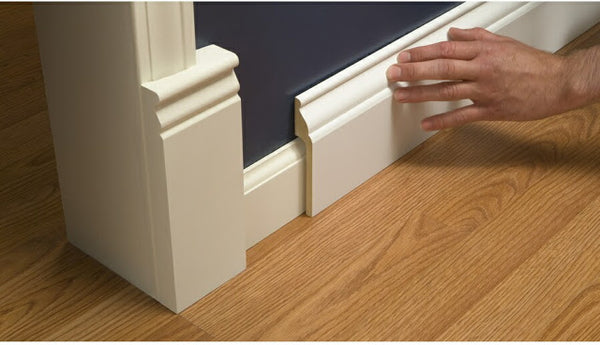
When it comes to trims and mouldings, this is one of the most essential. A baseboard can be found in almost any home or office.
A baseboard serves a number of purposes. They are used to seal the expansion gap between your floor and wall as well as to add a clean finishing touch to your room. A wide variety of baseboard designs are available to suit any style of room. Whatever the style of the room, this piece helps the room to feel complete, whether it is short, flat baseboards or intricate baseboards and crown mouldings.
- Where To Use It: On the base of the wall to transition floors to walls.
- Compatible Flooring: vinyl, carpet, wood, laminate, tile, rubber
7. Floor Bullnose Trim and Moulding
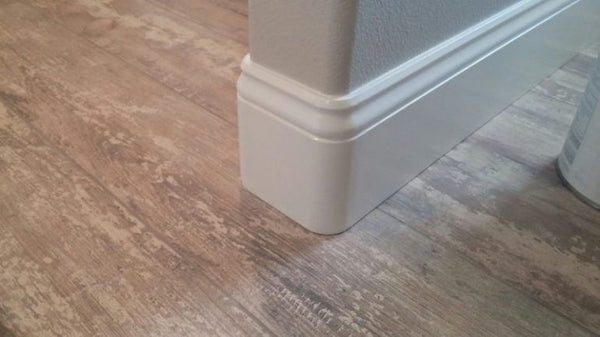
If you need a transition between your tile floors and your wall, the bullnose is the best option.
A bullnose trim is made of porcelain or ceramic tile with a rounded top and is placed over the existing tile to create a 90-degree transition. It is also durable and easy to maintain since this trim is usually sealed.
- Where To Use It: Similar to baseboards, use bullnose trim of the base of the wall to transition the floor to the wall.
- Compatible Flooring: tile, vinyl, wood, laminate
8. Cove Base Trim

The cove base trim is also made of tile. A cove base is very similar to bullnose trim; however, it has a curved bottom that slopes into the tiles to create a natural slope. The cove base trim is both tough and durable, and it is extremely easy to maintain. It is most commonly used in restaurants and businesses for its ease of cleaning.
- Where To Use It: On the base of the wall of which wall tile is being used to transition tile floors to wall tile. Often used in high-traffic areas like businesses or restaurants.
- Compatible Flooring: tile
The Importance of Floor Trim And Moulding
Floor trim and moulding play a crucial role in enhancing the aesthetic appeal and safety of your flooring. They create a seamless transition between your flooring and the walls, adding a polished and finished look to your interior. Apart from enhancing the aesthetic appeal, floor trim and moulding also provide practical benefits. They protect your flooring from scratches, dents, and other damages that may be caused by furniture or foot traffic. Mouldings can further add structural support to your flooring, and they can also be used to cover up unsightly gaps or imperfections in the flooring installation. In summary, floor trim and moulding are essential finishing touches that can truly elevate the look and durability of your flooring.
Other flooring blog articles you may want to read:
The Complete Guide To The Best Flooring For Your Home
